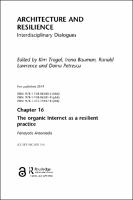Chapter 16 The organic Internet as a resilient practice
Proposal review
| dc.contributor.author | Antoniadis, Panayotis | |
| dc.date.accessioned | 2018-11-01 23:55:55 | |
| dc.date.accessioned | 2019-10-17 14:41:48 | |
| dc.date.accessioned | 2020-04-01T11:55:32Z | |
| dc.date.available | 2020-04-01T11:55:32Z | |
| dc.date.issued | 2019 | |
| dc.identifier | 1002499 | |
| dc.identifier | OCN: 1082955120 | en_US |
| dc.identifier.uri | http://library.oapen.org/handle/20.500.12657/27508 | |
| dc.description.abstract | The idea that digital and physical space are increasingly interconnected, and that architecture and urban design should be conceptualised beyond buildings, streets and so on, is rather old and well understood. What is less clear is the fact that digital space is socially and politically ‘produced’ in similarly complex ways to the physical. It is thus subject to power structures, manipulation tactics, fundamental rights, borders and constraints, despite its perceived ‘infiniteness’. | |
| dc.language | English | |
| dc.subject.classification | thema EDItEUR::U Computing and Information Technology | en_US |
| dc.subject.other | Internet | |
| dc.subject.other | organic internet | |
| dc.subject.other | digital space | |
| dc.title | Chapter 16 The organic Internet as a resilient practice | |
| dc.type | chapter | |
| oapen.relation.isPublishedBy | 7b3c7b10-5b1e-40b3-860e-c6dd5197f0bb | |
| oapen.relation.isPartOfBook | 3d275921-2909-4022-b37c-11c8f6f19d6c | |
| oapen.relation.isbn | 9781138065819; 9781315159478 | |
| oapen.imprint | Routledge | |
| oapen.pages | 11 | |
| oapen.identifier.ocn | 1082955120 | |
| peerreview.anonymity | Single-anonymised | |
| peerreview.id | bc80075c-96cc-4740-a9f3-a234bc2598f1 | |
| peerreview.open.review | No | |
| peerreview.publish.responsibility | Publisher | |
| peerreview.review.stage | Pre-publication | |
| peerreview.review.type | Proposal | |
| peerreview.reviewer.type | Internal editor | |
| peerreview.reviewer.type | External peer reviewer | |
| peerreview.title | Proposal review | |
| oapen.review.comments | Taylor & Francis open access titles are reviewed as a minimum at proposal stage by at least two external peer reviewers and an internal editor (additional reviews may be sought and additional content reviewed as required). |

